The success or failure of this transition does not depend solely on the deployment of a system.
The critical transformation concerns the corporate culture, the evolution of which is parallel to that of the use of technologies. Companies that do not take this into account should expect to encounter obstacles. Think of most of the cloud migration as a business issue, not a technical issue. In the IT industry, it is often thought that cloud migration is about leveraging servers hosted on third-party platforms. But companies do not pay for Amazon, Microsoft, or Google servers.
What cloud providers offer is primarily operational know-how. Companies that embrace the cloud are benefiting from years of research and development in automation, orchestration, surveillance, and artificial intelligence. This is not about servers, but about adding value to the business through the interaction of cloud servers served by software dedicated to this task. To make the most of the cloud and multi-cloud, it is not enough to make a purchase order. If we can just buy the technologies, the operations based on the latter must instead be integrated into
existing practices. The migration channel for a company to the cloud and multi-cloud is obviously based on several technological drivers.
A. Why Business Moving Towards Cloud Migration?
 Do not delegate cloud architecture Regardless of the type of project, it’s not just about migrating applications to the cloud. With those running on an external infrastructure, the burden of managing the architecture may seem lighter. But the IT sector is full of companies that have shirked their responsibility for designing the architecture and then discovered that the exercise is as essential in the cloud as it was for the systems hosted on-site. Some of the companies that migrated to AWS (Amazon WebServices)cloud have had to draw painful lessons about implementing application architectures to ensure the availability of critical cloud, despite cloud disruptions. Of course, this involves thinking about the location of the stored data and designing them replication and backup.
Do not delegate cloud architecture Regardless of the type of project, it’s not just about migrating applications to the cloud. With those running on an external infrastructure, the burden of managing the architecture may seem lighter. But the IT sector is full of companies that have shirked their responsibility for designing the architecture and then discovered that the exercise is as essential in the cloud as it was for the systems hosted on-site. Some of the companies that migrated to AWS (Amazon WebServices)cloud have had to draw painful lessons about implementing application architectures to ensure the availability of critical cloud, despite cloud disruptions. Of course, this involves thinking about the location of the stored data and designing them replication and backup.
These lessons are also valid for other major cloud service providers. Maintaining architectural control over what appears to be an outsourced service is essential. Processes and even the corporate culture must evolve to support both internal and external infrastructure. It is important to maintain rigor in the design and conduct of
change. Managing upstream of the Encore infrastructure today, it is surprising how much IT remains dependent on command-line interfaces used to activate equipment or software in isolation.
B. Concern Of Cloud Migration And How We Should Approach It?

Many companies continue to gauge future employees by degrees that demonstrate expertise gained for a specific set of products. The command-line interface is reminiscent of flying older aircraft that used separate physical controls for each engine, wing flap, wing, and so on. As planes have become more sophisticated, orders have become abstract. Even though physical controls still exist, they are now activated by a set of more abstract complex controls that have transformed the way of driving. It’s the same for the cloud.
There are still underlying servers and switches, but the controls need to become more abstract. This means that operations managers need to be more proficient in using these commands, specifying their objectives without having to worry about the operation of each device or software. In the end, it does not matter which cloud the application workload is based on, the operators must be able to define the desired results and let the orchestration systems do the work. To prepare for this type of control, they will have to become familiar with a range of tools that evolves rapidly. Whether it’s Hashicorp’s Terraform, AWS CloudFormation or Microsoft’s ARM models, the future of system provisioning and administration is unlikely to be syntactic constructs rather than tools automated.
Bridging the Skills Gap Any change in tools is changing the way people interact with technology. If companies often think they can hire new skills, in fact, relying on recent recruits to undertake that cloud migration can be painful or even disastrous. First, the cloud, despite all the hype, is still emerging. Unless a company is born there, most who benefit from it still runs most of its applications on a more traditional infrastructure. Naturally, most of the IT teams still spend a lot of time on legacy environments.
C. Pros and Cons of Cloud Migration
I. So, even if there are numerous trends to search for skills in the cloud, the reality is that there is still no pool of professionals with significant experience.
II. Moreover, those who dispose of it are in great demand, putting them beyond the reach of many companies.
III. The most enlightened IT managers will go even further by involving them in decision-making in order to involve them in the company’s future strategies.
IV. In doing so, they give the teams the feeling of contributing to its growth.
V. Finding your rhythm All of these changes are hard enough to do without any outside pressure.
VI. The ambient noise is too loud, but you must know how to extract it. All the hype, all the speeches, all the experts.
D. Cloud Migration: A Right Decision?

IT Executives has an opinion, and these are shared in the biggest echo room in the world. The only truth to consider is yes, the transformation takes place and companies, big and small, are aware of it. However, there is no silver bullet and although there are experts to advise you throughout this trip, no one can do it for you.
Is there urgency? Certainly. But this is not a reason for making decisions that are too fast and inconsiderate. The transformation, even in good conditions, is already difficult and can become almost impossible when one tries to lead it under the yoke of an unnecessary constraint. It is necessary to move in this direction as quickly as possible. But this rhythm must be dictated by the company and not by external actors.
Not being confident about the level of maturity with the cloud is useless: this feeling rarely improves the quality of execution. Businesses must first and foremost ensure that the migration to the cloud is done on their own terms, whatever they may be.

